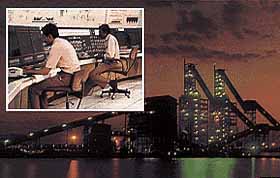Direct Reduction: Combustion Technology
|
Midrex direct reduction plant with control room (inset), Essar Steel, Hazira, India. |
Equipment
Combustion Technology
Energy Consumption
Process Description
R&D Trends
The DRI processes outlined in the Process Equipment section were either natural gas or coal-based. A combination of fuel feed at the charge end of the reducing furnace, and fuel injection at various stages of the process were employed. The combustion processes in these furnaces are highly dependent upon the manner in which the fuels are introduced into the furnaces.
Additional information:
Midrex – the Midrex gas-based process utilizes a vertical shaft furnace that has preheat, reduction, and cooling zones. The reducing gas is ported into the reduction zone through a bustle pipe that is located at the bottom of the reduction zone, while the charge is introduced at the top of the furnace. Combustion occurs as the reducing gases flow countercurrent to the charge. The excess top gases are combusted as fuel for the reformer burners. The hot flue gases from the reformer are passed through heat recuperators to preheat combustion gases for the reformer burners, and also to preheat the process gases before reforming. Usage of the heat recuperators have significantly raised the efficiency of the process.
HYL – The HYL gas-based process uses four vertical reactors. The main combustion processes occur in the initial and main reduction reactors, as well as in the gas reformer. The fresh reducing gas that originates in the reformer is gradually heated by passing it through the cooling reactor, the main reduction reactor, and then finally the initial reduction reactor. Before entering the reduction stages, the reduction gases are indirectly heated by a gas-fired furnace. To further heat up the reducing gases, air is injected at the entrance to the reactor and is used during the combustion of unreformed hydrocarbons. The process tail gases are used as fuel for the reformer and for the gas-heating furnaces.
ACCAR – The ACCAR coal-based process uses a rotary kiln furnace that is inclined at 3-4% of the horizontal. The charge (coal, lump ore, and/or iron oxide pellets) is fed in at the upper end of the kiln, while liquid and/or gaseous fuels are injected into the kiln from beneath the bed. Air is injected into the kiln from above the bed, and is used in the combustion of the coal and liquid and/or gaseous fuels during the reduction process. The coal feed is carefully controlled to ensure total coal combustion as the burden enters the final reduction stages. The additional fuel injected through the ports is also closely monitored in order to maintain an optimal temperature profile and gas composition along the length of the kiln. Combustibles released from the bed are combusted in the kiln freeboard. The final reduction occurs with liquid and/or gaseous fuel introduced through the kiln shell ports near the product end of the kiln as they pass under the solids bed.
SL/RN – The SL/RN coal-based process also uses a rotary kiln inclined at 3-4% of horizontal. All the coal feed is introduced at the upper end of the kiln to ensure a uniform temperature distribution along the length of the reduction zone, and to ensure that combustion takes place at the bed surface. In addition, a uniform reduction zone temperature is maintained by introducing air into the kiln for the combustion of combustibles released from the bed. Auxiliary fuels such as natural gas and oil are burnt at the discharge end for plant start-up.
Davis, C.G, J.F. McFarlin, and H.R. Pratty, “Direct Reduction Technology and Economics”, Ironmaking and Steelmaking, Vol 9. No. 3.

